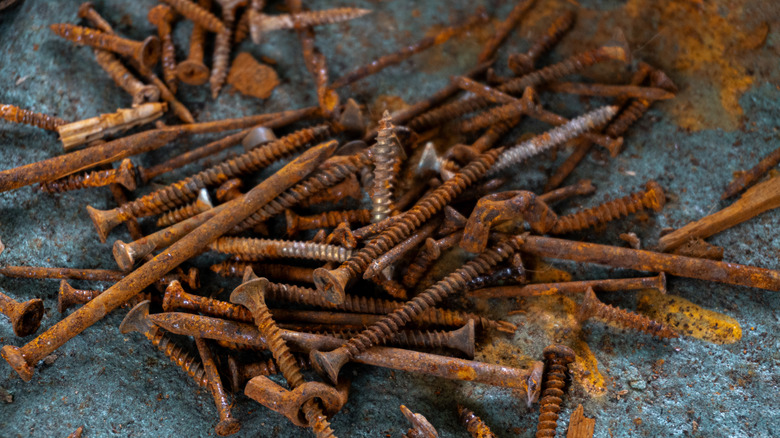Don't Throw Out Old Nails - Use Them To Add A Vintage Look To Your Furniture Instead
It sounds a little like something out of a Sherlock Holmes novel – the ability to tell if an antique couch is a fake by spotting the brand-spankin' new nails that hold one of the sofa's arms in place. In real life, such an anomaly in a piece of furniture would still stand out. However, what's more likely than the piece being fake is that it was actually repaired with a brand-new shiny nail, giving off the impression that it's a knock-off instead of a sought-after antique collectible. This scenario right here is one of the chief reasons why you should keep the old nails you find instead of tossing them. Those oldies, but goodies, have that old-nail patina that you won't find on new nails, but which would be present on a piece of antique furniture.
When a piece of metal develops a patina, you're seeing the metal's aging process in action. With copper, the change is easy to spot because it transitions from that brassy, brown-orange hue to green. These changes occur over time as the metal is exposed to the elements, including oxygen, as well as pollutants and other environmental stressors.
Most nails today are made of steel. As such, there is a visual trajectory that you'll witness as the nails develop a patina layer. First, they'll take on an orange-ish hue that will eventually be followed by a dark brown color. (It's the patina that gives steel a tarnished look.) So, if you want to update your furniture, save the newer nails for more modern pieces and use the old ones to keep your vintage furniture looking vintage.
What's the difference between rust and patina?
Given that the initial colors of a patina'd nail fall in the orange range, it's easy to see why patina and rust (also called iron oxide) get confused sometimes. Both take on a decidedly orange hue. Your ability to tell the difference between patina and rust will probably come down to spotting the orange powder or flakes on the old nails. If you do, you're dealing with the effects of rust. The acidic electrolytes in water are responsible for rusting steel.
To be fair, many antique collectors appreciate the look of rust in the right circumstances because the appearance of rust makes a piece look authentically old. However, in terms of preserving your vintage and antique pieces, it's useful to know that over time, the effects of rust will break down the metal and decrease its value. It is no exaggeration to say that the rust, which is a form of corrosion, is eating up the steel.
Because of this, rust can lead to structural support problems. It's easy to think of weak rusted steel in relation to the rusting bridge that will eventually collapse. However, the rusty nails holding your furniture together could also break due to the damage, and potentially damage the piece over time, depending on what the nail was holding together. In light of this, you'll want to determine whether you're looking at rust or just patina on the old nails before you refurbish your antique furniture. It's worth a look, though, because it's an investment in your antique furniture that only gets lovelier over time.

